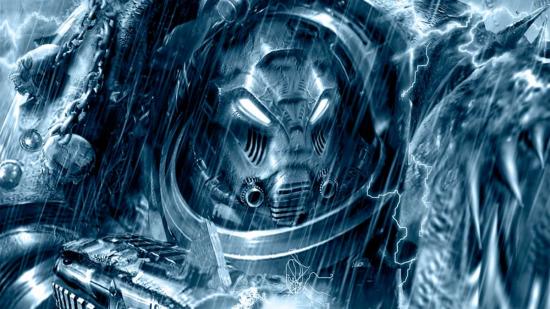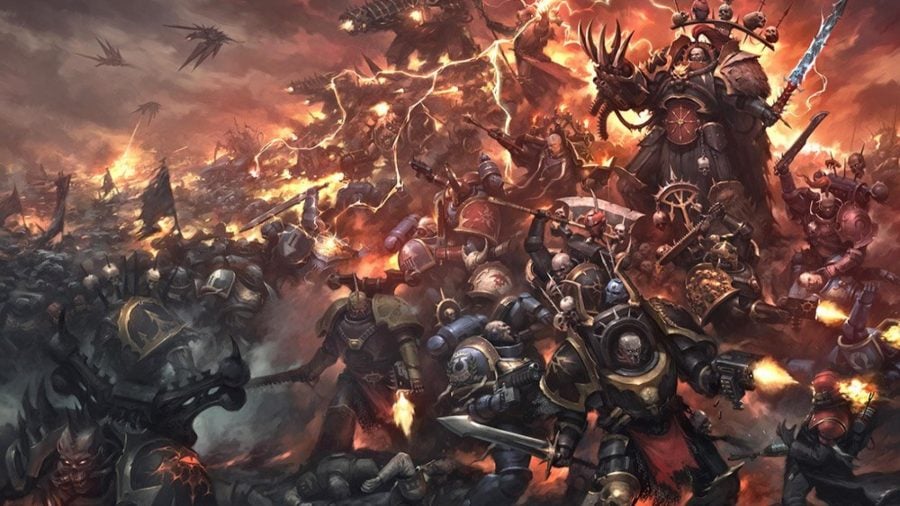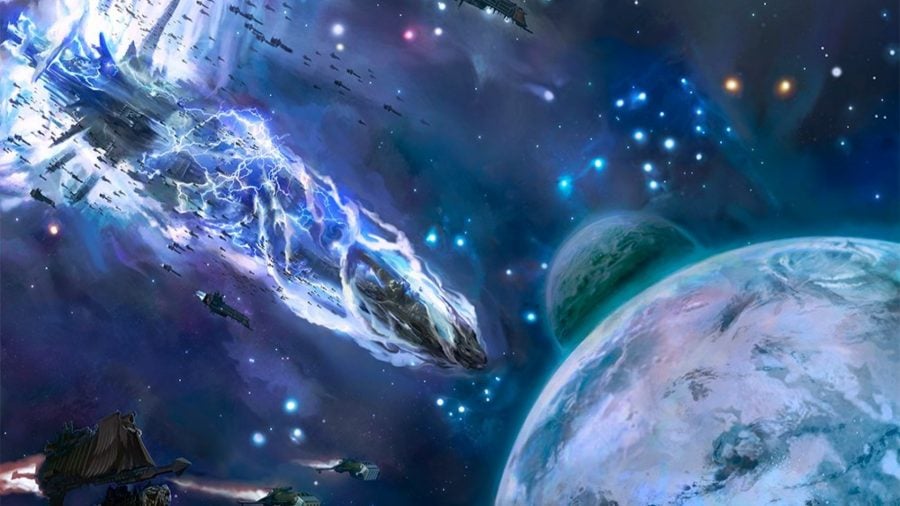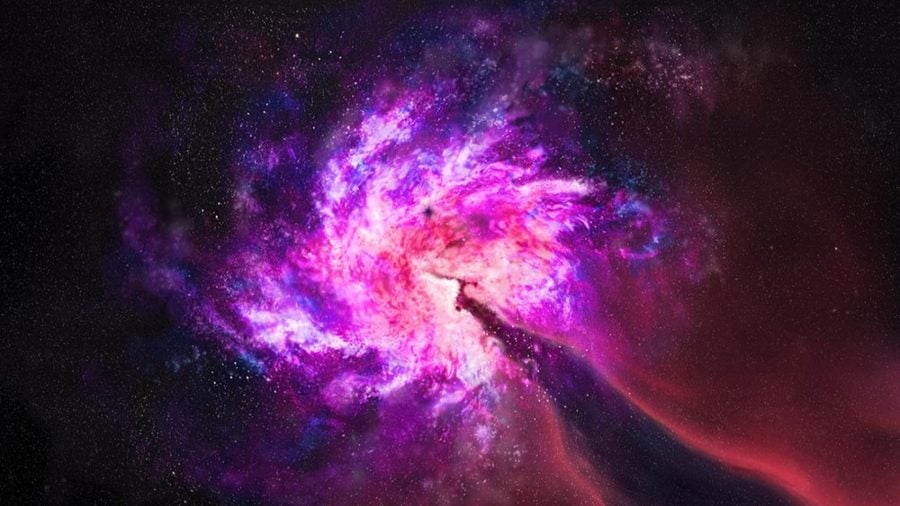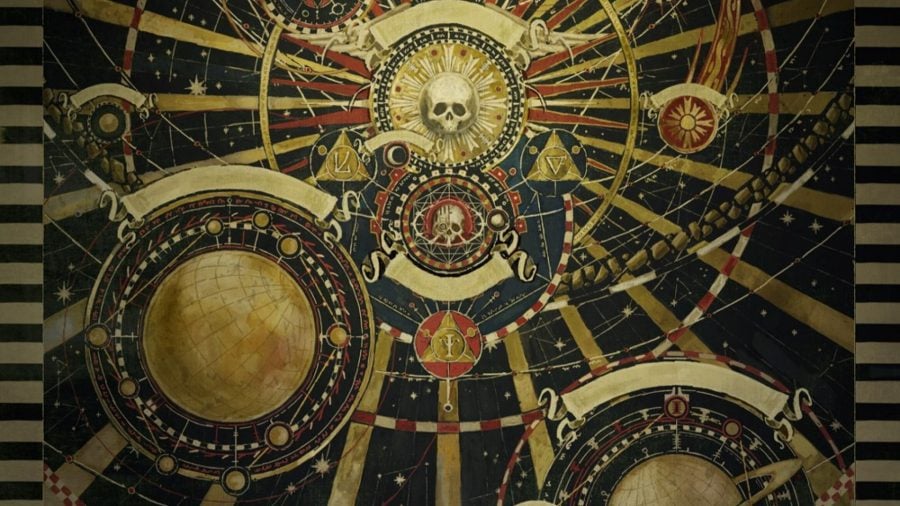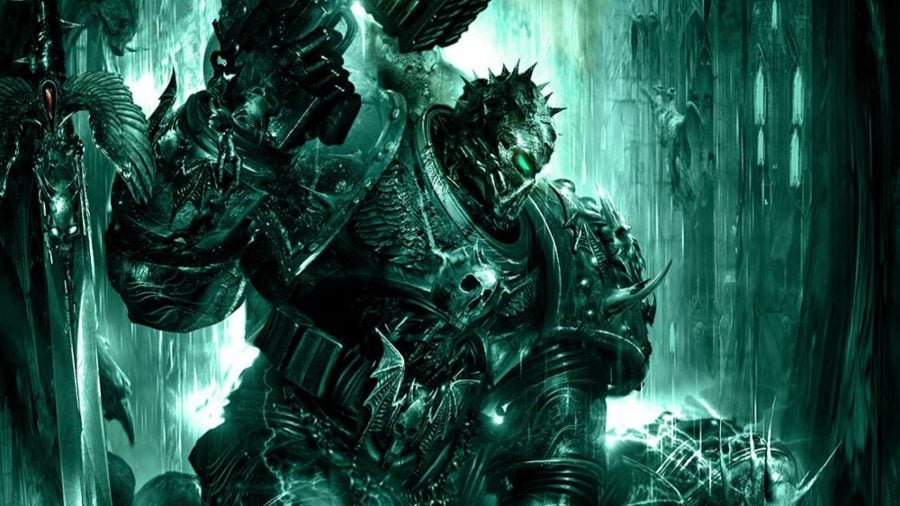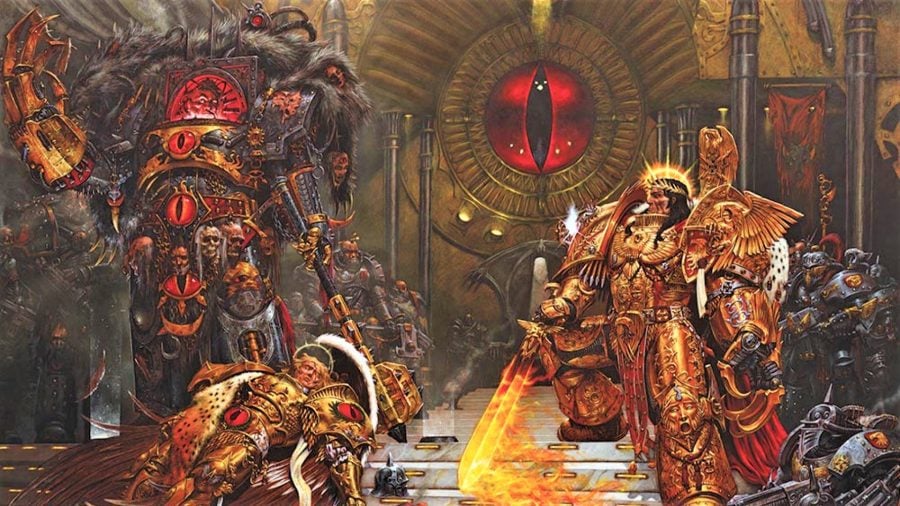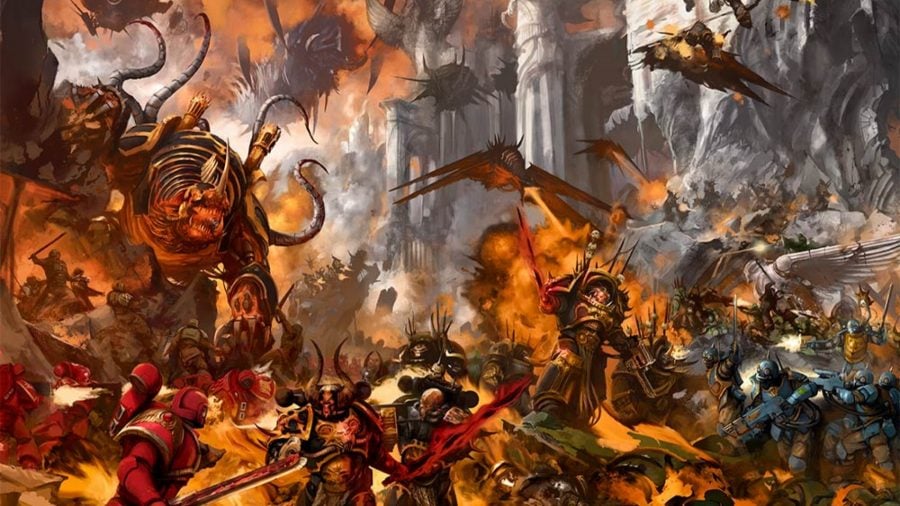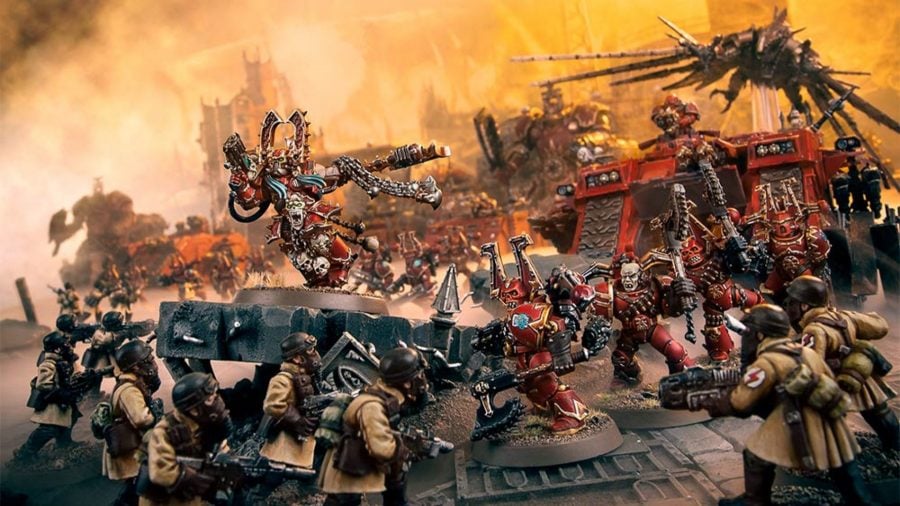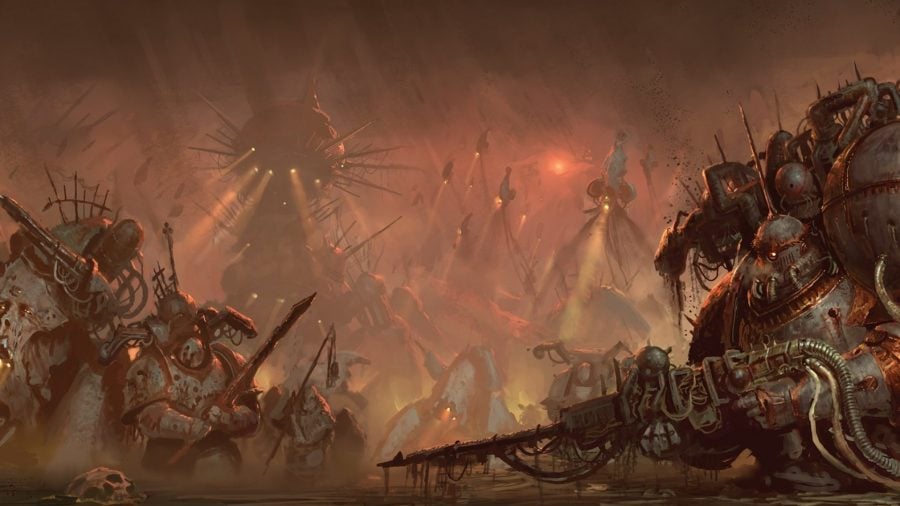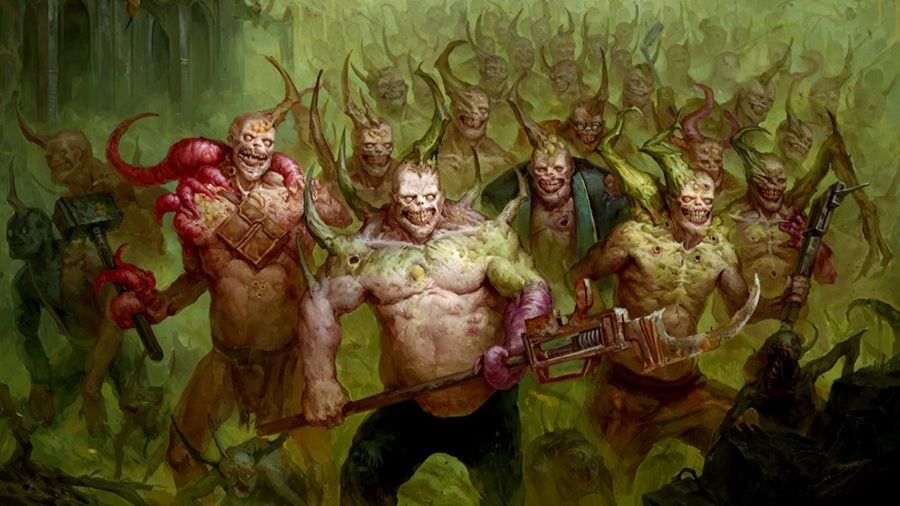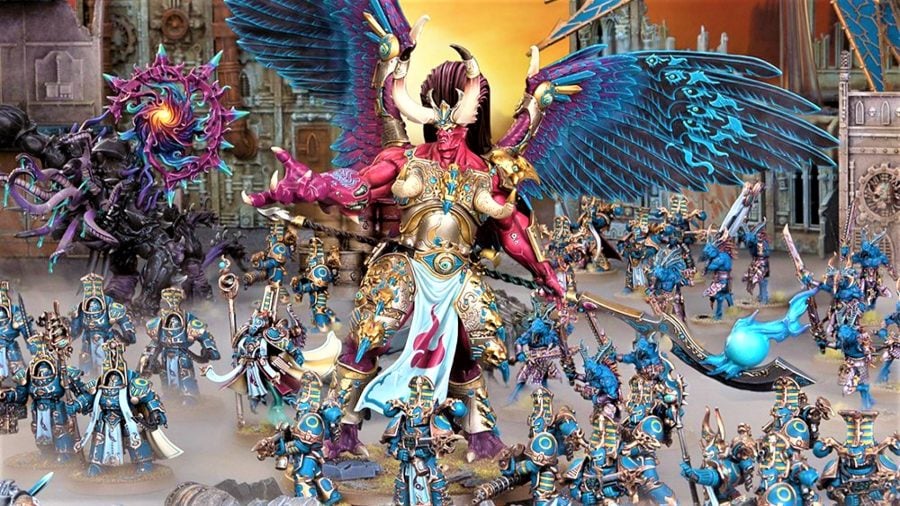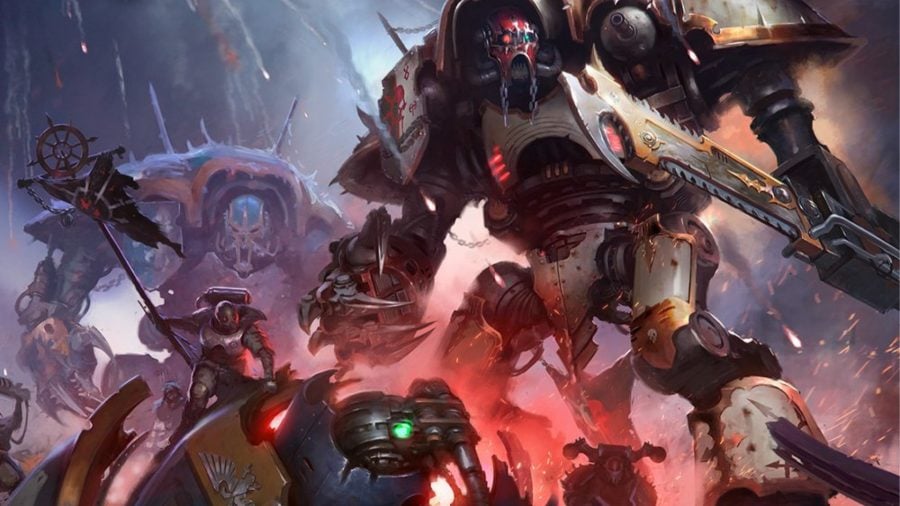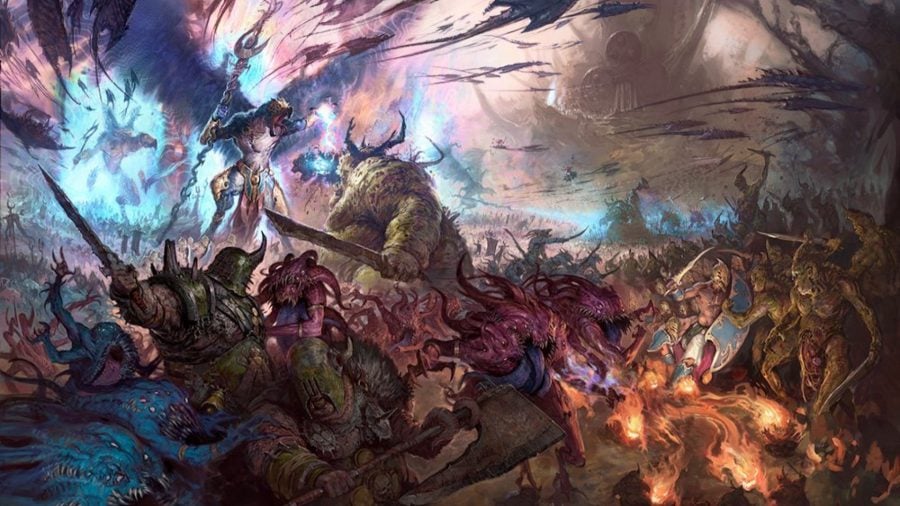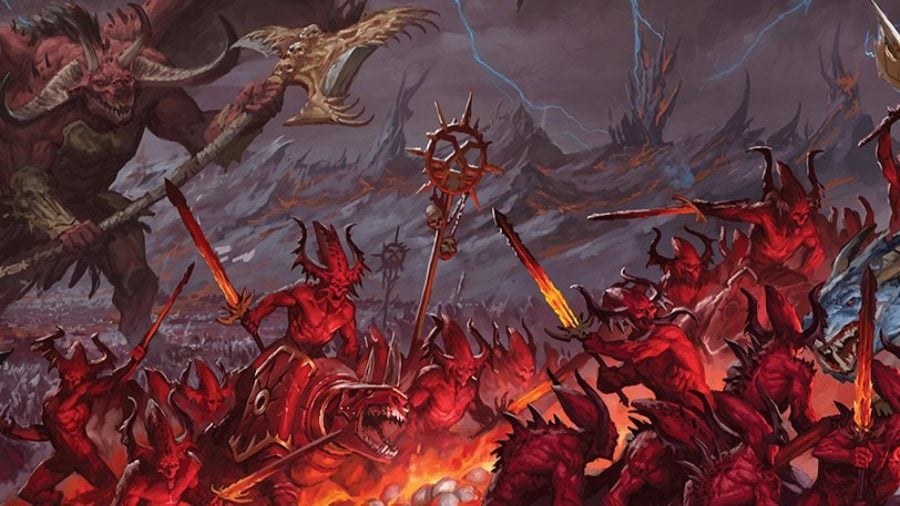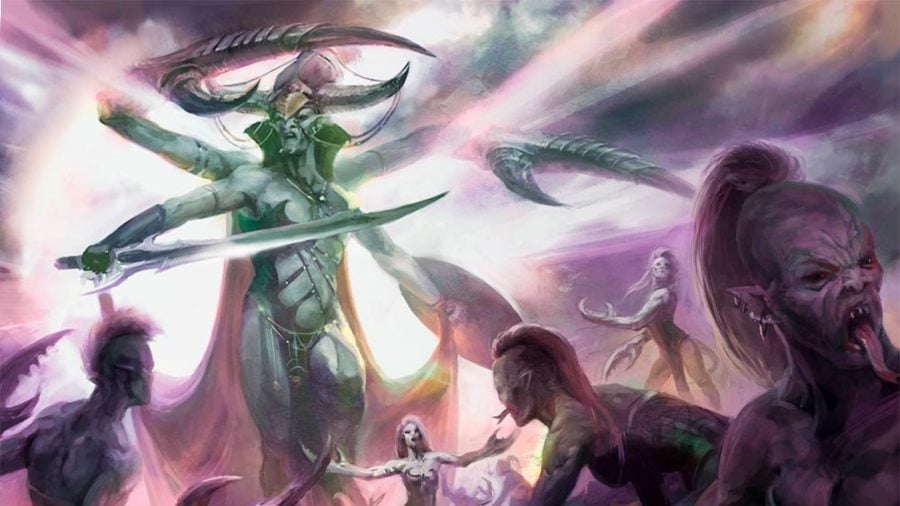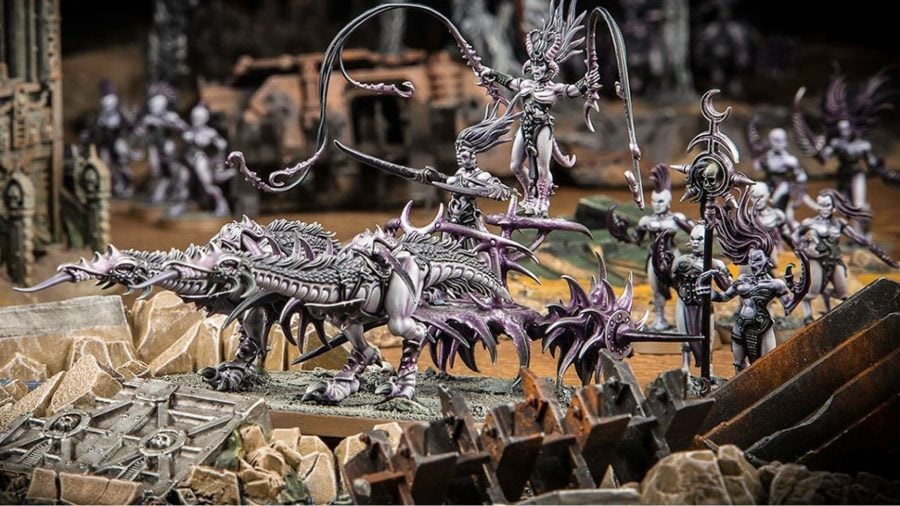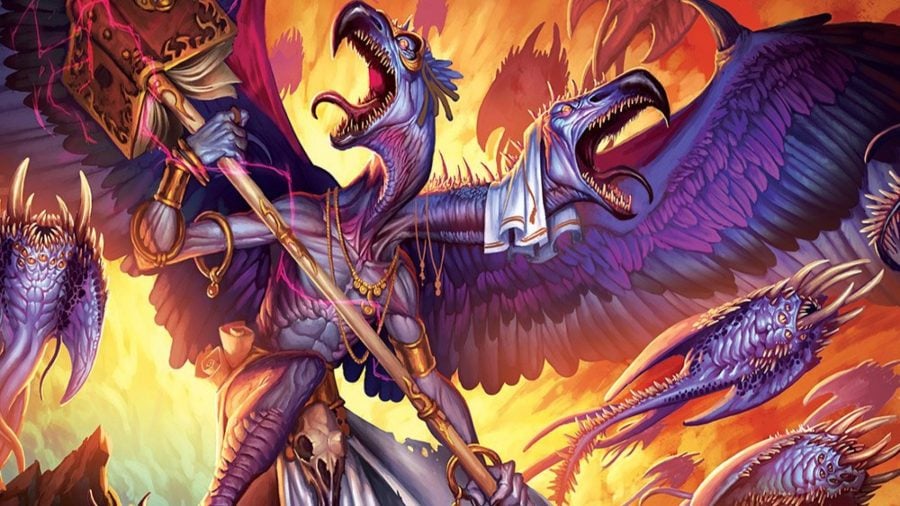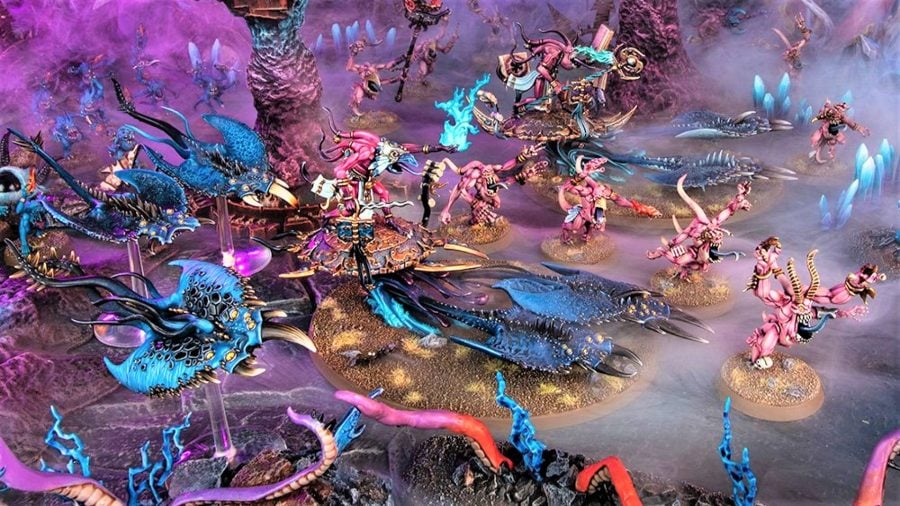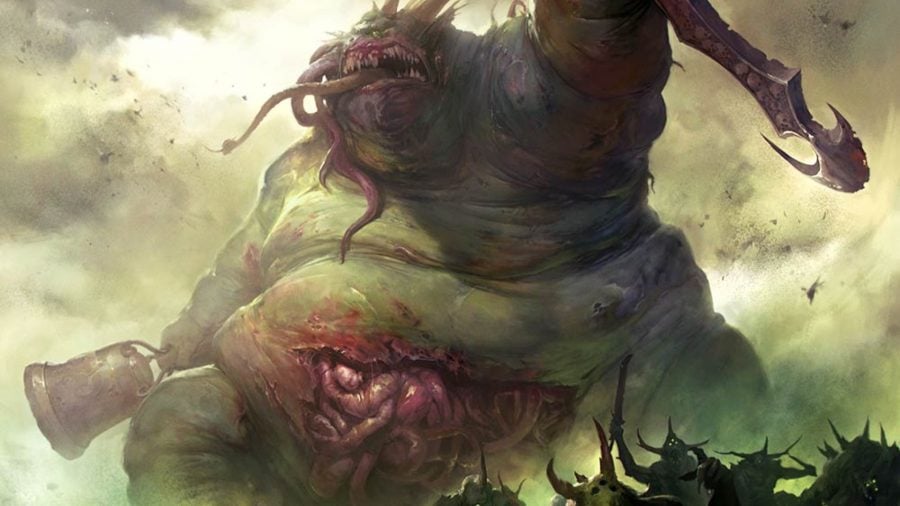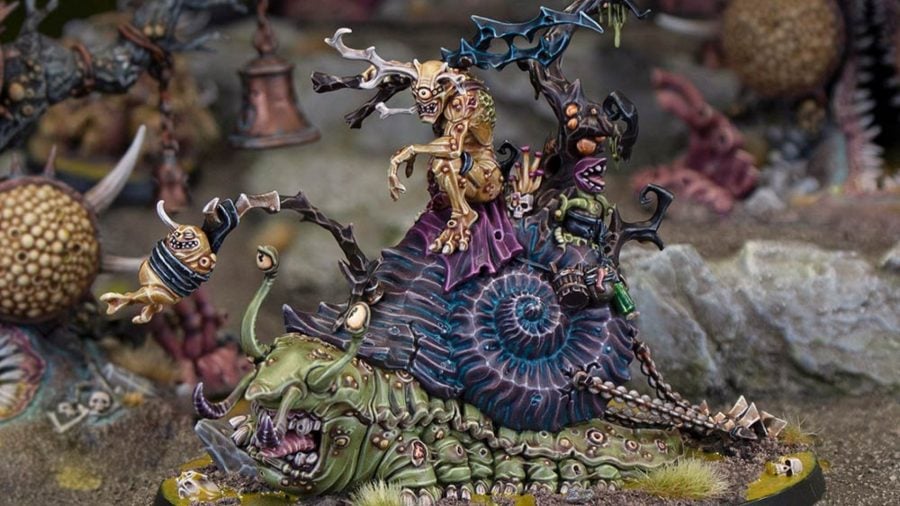In Warhammer 40k Chaos is many things: a metaphysical concept; an ever-present, corrupting force; a pervasive religion found all over the galaxy – and, of course, one of the main groupings of factions in Games Workshop’s gothic sci-fi tabletop wargame. It’s known as the Primordial Annihilator; to the Imperium of Man it is the Arch-Enemy.
Chaos has as many names as it does contradictions, but it’s always there, beneath the surface, and (depending on your perspective) is either the ultimate truth of the 40k universe, or its ultimate evil. Confused? Don’t worry – this guide will explain all, and give an overview of 40k’s main Chaos armies too. Trust us, this is one area where you are going to be glad you did the background reading.
If you’d rather get a brief overview of all the armies fighting over the 40k universe, try our full guide to Warhammer 40k factions – or zoom in on the other two-thirds of the setting with our guides to the Warhammer 40k Imperium of Man, and the various Warhammer 40k Xenos races.
Otherwise, stay here and take a walk on the (very) dark side…
Here’s everything you should know about Warhammer 40k Chaos forces:
Right then – fire up the engines, smoke ‘em if you got ‘em, and prepare for warp translation, because that galaxy ain’t gonna burn itself, baby…
The Warp
The Warp is perhaps the most surprisingly complex, intellectually stimulating concept in all 40K lore, and we guarantee it will deepen your enjoyment of the game and its fiction, especially if you’re looking to collect a Chaos force.
Every great science fiction universe has its own jargon-cloaked, fantastical method of bending physics’ laws to travel faster than light across the vastness of space. Star Wars has hyperspace, Star Trek has its warp drive (or, in Star Trek Discovery’s case, travel via the mushroom dimension), The Hitchhiker’s Guide to the Galaxy trumps the lot with its infinite improbability drive.
Warhammer 40k is a bit different. It doesn’t play well with others. Its long, jet-black dyed hair is swept across one eye in an emo fringe, it wears hobnail boots, and it keeps getting sent home from school for setting fire to the desks.
In the 40k universe, faster-than-light travel is achieved by forcibly tearing a hole in the fabric of ‘reality’, then flying your spaceship through it, into The Warp – a hostile, transdimensional nether-realm composed of the souls (or emotions, spirits, psychic echoes, whatever makes you least scared) of countless trillions of unsuspecting mortals across the universe.
From this omnipresent, immaterial realm stems the most pernicious and nefarious enemy of the mortal races in 40k, the reason for the civil war that split the Imperium of man and the reason why its ‘immortal’ Emperor of Mankind is now a wasted skeleton wired to a chair: the malign and ever-tenacious forces of Chaos.
Warp travel plays a vital part in the 40k universe, allowing goodies and baddies (just kidding, there are no goodies) to travel from fight to fight without all their soldiers dying of old age on the way.
Assuming you’ve got a good Navigator (a three-eyed psychic mutant with the unique ability to chart safe paths through the Warp); a functioning Gellar Field (an energy shield around the ship to keep reality in and unreality out); and a healthy dose of luck, your civilisation can use this terrifying technology to make that crucial leap to interstellar travel, albeit in the most gothic-horror way possible. Just so, in point of fact, did the human race first spread itself across the stars, in the famed Dark Age of Technology, starting around the 15th millennium AD.
But the Warp is not a benign, passive sea to be safely sailed across with nary a care. The Warp is reality’s roiling, twisted shadow, an infinite repository of all the raw, unbound energies that are generated by the beings of the material world, but cannot exist there, in its three or four tawdry little dimensions.
The Warp is pure Chaos, and everything that dwells there – from the lowliest, barely-sentient wisp of psychic energy to the four transcendently powerful entities we know as the Ruinous Powers – and, speaking of…
Chaos gods
Mostly, the Warp is an unplottable morass of shapeless, ever-changing forces and psychic screams – but, amidst the Chaos, four transcendent, immeasurably powerful beings exist, eternally warring among themselves to claim lordship over all and realise their dark desires.
These so-called Chaos gods are the personifications of all the deepest metaphysical aspects of mortal beings; they are our darkest sins, dreams, fears, and vulnerabilities made manifest: immortal, immaterial avatars of every thought and emotion we struggle to master, but can never escape.
Khorne, the blood god, is rage, murder, and vengeance incarnate; he is the roaring killer instinct at the heart of even the meekest mortal souls.
Nurgle, the plague god, is disease, decay, and entropy made flesh; the weakness and corruptibility of all living things; the fear of sickness and death; and the irony that all death feeds new life.
Tzeentch, the Changer of the Ways, is fate and destiny; the cruel inescapability of cosmic happenstance; and the deadly promise of ambition and forbidden knowledge that brings inevitable damnation.
And Slaanesh, the Prince of Pleasure, is obsession, desire, and excess – the ever-hungry inner void, the whispering voice inside your head that craves constant sensation; they are seduction, addiction, gluttony, selfishness, and self-destruction in one.
The Chaos gods desire, above all, to break free into the material universe and feast upon its bounty of living souls. If they succeeded, they would tear down any semblance of order and create a playground of unmitigated torture and destruction, where the Ruinous Powers’ every capricious, sadistic whim could be enacted on a galactic scale, until finally there was nothing left, anywhere. Nothing. Not even a Starbucks.
So, what protects us squishy, emotional, biocomputer-driven meat-sacks from being swallowed up by that daemonic apocalypse? Well, the metaphysical membrane that separates reality from the Warp is tricky to puncture.
Warp entities can only manifest themselves in the material plane when the conditions are just right; ordinarily when there’s a huge outpouring of psychic energy in a specific spot, to weaken that protective veil and bolster the burgeoning sea of souls beneath.
Such events could be massive psycho-social phenomena ridden with death, pain and suffering – like wars, genocides, or deadly pandemics. But occasionally, just one small deed – one murder, one betrayal, one singular sin – can, with the right psychic significance attached, be enough. It’s these crucial moments that the beings of the Warp need in order to enter our world and start feasting.
And so, dear reader, we come to the crux of Chaos’ mission; you see, the beings of the Warp don’t just wait around for such atrocities to happen on their own, oh no. Since time immemorial, the Ruinous Powers have used their godlike abilities to seep their influence across the veil, into the minds and souls of unwitting mortals, corrupting them into willing, zealous servants whose purpose in life is to serve their dark gods, working to create those psychic fault lines through which daemons can come out to play.
The ranks of the dark gods’ real-space servants have grown with every millennium, as our galaxy descends further into constant, all-consuming war, and the Imperium into hypocritical tyranny. But even in the dying years of the 41st millennium, among their mightiest followers remain those fallen heroes who once counted themselves loyal subjects of the Emperor of Mankind. That’s right, it’s time for the…
Chaos Space Marines
Evil-looking and usually spiky versions of the noble Space Marines, the dread warriors of the Chaos Space Marines are the Ruinous Powers’ primary fighting force in the battles of the 41st millennium, and their story is exactly as dark and awesome as their backpack-skulls and human-skin cloaks suggest.
Around 10,000 years ago (that’s the late 31st millennium AD, math fans) a plan came to fruition that had been set in motion by the dark gods centuries before, to seed rebellion and chaos-worship among the Emperor’s trusted Space Marine legions. Through careful planning, the plotters finally succeeded in turning Horus, the Emperor’s most trusted, most senior Primarch marine, and Warmaster of all his armies, to the cause of the Ruinous Powers. It triggered a cataclysmic civil war – the Horus Heresy – that ultimately failed to overthrow the Imperium, but split the legions down the middle, killed trillions and left the Imperium of Man sundered, its beloved Emperor all but dead.
Of the 18 Space Marine legions fighting for the Imperium before the Heresy, nine of them sided with Horus against the Emperor – they were:
- The Sons of Horus (XVI Legion, the Warmaster’s own command)
- The Emperor’s Children (III Legion)
- The Iron Warriors (IV Legion)
- The Night Lords (VIII Legion)
- The Thousand Sons (XV Legion)
- The World Eaters (XII Legion)
- The Death Guard (XIV Legion)
- The Word Bearers (XVII Legion)
- The mysterious Alpha Legion (XX Legion).
Already changed by the creeping corruption of Chaos, many traitor Astartes survived Horus’ failed coup, fled the battle zone around Terra, and went their own way – most of them sailing, in desperation, directly into the Eye of Terror (a massive, tempestuous wormhole linking real-space to the Warp).
Although 10,000 real-space years have passed since then, the time-bending effects of the Warp mean that many Heretic Astartes who escaped into the Eye have lived far longer even than that, ceaselessly fighting what they call the ‘Long War’ – against one another as much as the Imperium. The nine legions and their offshoot warbands are therefore filled with ancient, battle-hardened veterans used to fighting tooth and nail for survival, territory, honour and the primacy of their chosen Chaos god.
There’ve been multiple attempts to unite all the traitor marines under a single banner – by far the most successful being the black-and-gold-clad Black Legion, led by Horus’ old right hand man Abaddon (look out for a guide on them soon). But, ultimately, Chaos Space Marines remain a disparate bunch, divided by old grudges and Chaos’ underlying tendency to sow discord, division and infighting, even among its own ranks.
On the upside, this makes for a big, messy, flavourful family of in-game factions, as each Chaos Space Marine force has its own detailed history, motivations, beliefs, ways of war and – of course – their own personal aesthetics and colour schemes for the twisted and profane mockeries of Astartes power armour, weapons and vehicles that they take to battle.
It means that, on the tabletop, Chaos Space Marine armies are some of the most diverse in 40K, with each Legion or warband favouring a different mix of units, between Astartes warriors of various loadouts, armoured vehicles and hulking dreadnoughts, crowds of unarmoured, meat-shield human cultists, warped chaotic hybrids, pure-strain daemons summoned directly from the warp, and even obscenely destructive, distorted daemon engines – malevolent warp-things forcibly bound by dark rituals into war machines.
Field a Word Bearers army and you’ll likely have a core of heretic Astartes warriors, led by psychic Chaos Sorcerers and Dark Apostles, driving before them a host of brainwashed cultists to soak up enemy fire while the psykers summon daemonic allies to your aid.
Choose the bitter Iron Warriors and you’ll want to double down on firepower, with Havoc marines, gun batteries and the ultra-deadly Obliterators – marines who’ve been twisted and mutated by a Warp-fueled techno-virus until they and their heavy weapons are a single, hate-filled abomination.
Pick the Khorne-worshipping World Eaters, and your lists will feature packs of bloodthirsty Berzerkers revving chainswords and chain-axes about the place, their brain-torturing implants driving them into a murderous frenzy for the glory of the blood god. There’s a flavour for everyone.
Before striking out to serve the dark Gods as champion of your own warband, though, make sure you explore the darkened under-decks of our full Warhammer 40k Chaos Space Marines army guide for more info.
Be aware, though, that not all heretic Astartes are created equal. If you really want to branch out with a fully-fledged standalone army, complete with its own custom models and rules, two of the traitor legions in particular have a little more to offer:
 Read our full Death Guard guide
Read our full Death Guard guide
Death Guard
The sons of Primarch Mortarion were once the loyal XIV legion, famed for their dogged endurance under enemy fire and dedication to reaching their objective to crush the enemy, however long it took and at whatever cost.
Beyond even the hardened physiology of most Astartes, the Death Guard were famously resistant to poisons and chemical weapons; Mortarion was even known for ritually drinking goblets of concentrated weaponised agents with his favoured warriors, to prove their immunity to all corruption.
Fast forward to the 41st millennium, however, and the Death Guard’s tragic fate has remade them in a grotesque mockery of the implacable purity they once celebrated.
Since Mortarion pledged his legion’s undying loyalty to the Chaos god Nurgle during the Horus Heresy, his Space Marine sons have become walking vectors of Nurgle’s many contagions.
The Plaguefather’s gifts make the Death Guard disgustingly resilient to damage, immune to pain and the ravages of time – but they also mean the Marines’ bodies are a constant petri dish of supernatural contagions, perpetually rotting, liquefying and repairing themselves, their corroded power armour (long since organically fused to their bodies) playing host to a menagerie of Warp-spawned parasites and creepy-crawlies. These guys are seriously gross.
On the tabletop, meanwhile, they’re one of the most popular and competitively successful armies right now, and their recently released 9th edition codex has further strengthened their foetid box of tricks.
Their terminator-armoured elite troops are now the terrifying in-game blenders they were always meant to be; the diseased Plagueburst Crawler and Myphitic Blighthauler daemon engines remain as potent as ever; and a new set of customised plague-concocting rules for Games Workshop’s Crusade campaign system adds some extra foulness to the broth.
Throw in some of the most characterful, impressive and fun-to-paint sculpts Games Workshop has ever produced – including the towering, bug-winged daemon Primarch himself – and you’ve got a big, smelly pile of fun.
If you can’t wait to accept Grandfather Nurgle’s liquefying gifts into your heart, and lead a vile Vectorium of your very own, dive right into the foul depths of our full Warhammer 40k Death Guard army guide.
 Read our full Thousand Sons guide
Read our full Thousand Sons guide
Thousand Sons
The Thousand Sons – the powerfully psychic, scholarly philosopher-soldiers of the XV legion – followed an especially tragic path into the damned service of the Ruinous Powers, and the well-intentioned, yet disastrous actions of their copper-skinned primarch Magnus the Red live in infamy, as crucial links in the chain reaction that brought the Imperium to its knees. You can find out the story of all the many things Magnus did wrong in our guide to Warhammer 40k memes.
Suffice it here to say that, in the 41st millennium, the Thousand Sons are paid-up, blue-and-gold-armoured acolytes of Tzeentch, the Chaos god of change and fate, having pledged themselves to the beakiest of the Powers in exchange for his help in their eternal search for deeper knowledge of the universe.
Their officer class of psyker marines are now potent chaotic Sorcerers, while – due to a catastrophic psychic mishap by the legion’s second-in-command, Azek Ahriman – the rank-and-file warriors are now Rubric Marines: soulless, empty suits of animated power armour, slaved to their superiors’ will.
As a tabletop army, the Thousand Sons are limited in their range of units; most lists will be some variation on a core of Rubric Marines, led by several Chaos Sorcerers, supported by some daemonic ‘chaff’ units. While the new Infernal Master character does have a place, you’ll often find Thousand Sons armies led by either Ahriman or the Daemon Primarch Magnus himself.
Their current, 9th Edition codex rules lean solidly into their role as a specialised psychic force (Chaos’s answer to the Grey Knights) and that does set them apart, making them feel distinctive to play. Let’s be honest, though – if you collect Thousand Sons, you’re mainly just there for the ancient-Egyptian-themed armour. Don’t deny it, or we’ll Smite you.
And, lucky for you, we’ve now got a full Thousand Sons army guide to educate you in their sorcerous ways.
Chaos Knights
The terror-inspiring Chaos Knights are ancient, towering war machines allied to the dark gods of the Warp. hen Horus turned to Chaos, it wasn’t just Space Marines that joined his cause. A huge chunk of the Mechanicum (the Emperor’s technology-worshipping martian allies) aided the Warmaster’s rebellion, along with several of its mighty Titan legions and a large contingent of knightly households. While many of their precious, ancient battle walkers were destroyed in Horus’ doomed attack on Terra, they weren’t all lost, and many of the surviving war machines and pilots remained loyal (if only in secret) to their dark masters.
Besides, in the subsequent millennia of Imperial tyranny and endless war, the allure of Chaos has seeped ever deeper into the Emperor’s vaunted million worlds, and many of the Imperium’s supposedly loyal knight-houses have since turned to the dark gods’ service. These Chaos Knights adorn their once-pristine mounts with the trademark grisly trophies, spikes, chains and warped bodywork of their new, infernal allegiances.
Like the loyalist Imperial Knights, these are chunky, incredibly detailed, and imposing models, oozing with threatening personality and replete with opportunities for modelling and painting customisation. Also like Imperial Knights, each one costs an absolute bomb at £95 RRP for the smallest class, but, since an army might only be three models, they’re conceivably among the cheapest armies to buy (as well as being a strategically simple choice for beginners).
Chaos Daemons
You knew these beasties were coming. Like we said, Chaos’ fundamental goal is to permanently split open the soggy dimensional trampoline protecting real-space, in order to spread discord and destruction across all of existence.
Whenever the veil becomes thin enough for the never-born creatures of the Warp to manifest in real-space and have a bloody good go at doing that, they take on three-dimensional form as a whole, horrific range of gribbly creatures – from the almost adorable to the unimaginably hideous. In games of 40K, they can either be fielded as allies to Chaos Space Marines, or as fighting forces all their own.
Now, while there are theoretically infinite varieties of never-born, the major types fall into four tribes, clustered around their patron gods.
Khorne Daemons
The red, horned ones that crib off satanic myth. The blood god’s daemon servants favour red scales, long tongues, fire under the skin, and great blackened swords and axes of Warp-metal. Daemonic manifestations of rage, murder, vengeance and destruction, Daemons of Khorne range from the comparatively dinky Bloodletter foot-soldiers, up to the colossal, bat-winged Bloodthirsters. There are several more species and almost all of them have ‘blood’ in their names.
There’s not much more to understand about these folks, they’re just very keen to get at your red stuff and take your skull back to their angry daddy. On the tabletop, they play accordingly: run forward, hack, slash and bite, yell “skulls for the skull throne” a lot – job done. Perfect if you play a lot of DOOM and really like Tenacious D.
Slaanesh Daemons
The voluptuous pinky-purple ones that demonstrate a closer-than-usual relationship between shapely human breasts and giant lobster-claws. The Dark Prince’s kink-obsessed never-born followers are all about pleasure and pain – both giving and receiving – with a battlefield focus on finesse and vicious, unmatched swiftness.
Their Daemonette foot-soldiers flip and spin acrobatically, slashing throats with their clawed limbs, while cavalry mounted on bizarre, reptilian anteater-horse hybrids and spindly, blade-covered chariots rush enemy lines. Towering above them all are Slaanesh’s Greater Daemons, the deadly, hoof-footed, stocking-wearing Keepers of Secrets.
Slaanesh Daemons boast some of 40K’s most beautiful – and haunting – models, in the form of the new Keeper of Secrets, Syll’Esske and the uniquely gruesome Infernal Enrapturess, making for a goldmine of satisfying display-piece models to paint – and an endlessly edgy army that will never fail to draw admiring eyes on the gaming table.
Their playstyle is challenging to master, as their lack of ranged attacks makes them ultra-vulnerable to massed gunfire, unless you can get to enemy lines quickly. But, if you can master their psychic and aura abilities to maximise speed and killiness, you’ll be slicing and dicing in no time.
Tzeentch Daemons
The brightly-coloured, mostly bird-like ones. Daemons bound to the Changer of Ways come in two broad flavours. Firstly, there’re feathery birdlike humanoids in the vein of Tzeentch’s Greater Daemons, the twin-headed bird-dragon Lords of Change.
Secondly, we have several varieties of shapeless, many-mouthed tentacular terrors – ranging from the apparently cute Horrors (which start off one colour, then gleefully split into multiple, different-coloured copies just when you think you’ve killed them) to the fast-moving, sharp-spined flying Screamers – ravenous airborne stingray daemons that’ll descend upon you in the blink of an eye and embrace you in a warm blanket of oscillating fangs and digestive acids.
Mainly used as allies to Thousand Sons or vanilla Chaos Space Marines, and rarely seen as a stand-alone army in 40K, Tzeentch daemons are generally agreed to need “a bit of TLC” from Games Workshop as regards their tabletop rules. Like Slaanesh, they lack the ranged firepower other armies have, but unlike Slaanesh, they don’t have many beastly melee abilities to make up for it.
Still, they’re maybe the most eye-catching, colourful army choice you could make, and, for our money, the Lord of Change still ranks among the most fantastic-looking, table-dominating miniatures in all of Warhammer.
Nurgle Daemons
Revolting, greenish, leaking, pestilential, pustulent – name any adjective that makes you feel a bit sick, and it can accurately describe the never-born children of merry old Grandfather Nurgle. When Nurgle’s daemons arrive on the battlefield, they form a bridge between real-space and their patron’s own domain within the Warp (lovingly referred to as Nurgle’s Garden) which immediately spreads corruption and putrefaction from their every footstep, weakening enemies and increasing their own powers.
The never-born forms in the Plaguefather’s armies are a diverse bunch, ranging from the horned, distended and misshapen but still humanoid Plaguebearers, through medium-sized creatures, such as the simple-minded, happy-go-lucky bulldozers that are the Beasts of Nurgle, right up to the gigantic, corpulent Great Unclean Ones, made in the rotten, grinning image of Nurgle himself. Oh, and remember we said Nurgle’s Warp-realm was a garden? Well, here’s the gardener, Horticulus Slimux:
Yep, that’s the sort of thing you can actually own for yourself as a Nurgle daemons collector.
On the battlefield, Nurgle Daemons pair perfectly with their Astartes allies in the Death Guard, but are equally viable as a standalone force – perhaps even more than the other Daemon armies, due to the uncommon survivability gifted them by their Disgustingly Resilient rule.
Besides which, just like the Death Guard, these yucky chaps are an absolute blast to paint – they’re forgiving for beginners, because making a mess is firmly allowed – encouraged, even – and yet still harbour so many disgusting details that more advanced hobbyists can go to town on making those weeping lesions and poisonous boils look as lifelike as possible. Recommended for iron-stomached warhammerers who want to win by forcing their opponents to skip lunch.
